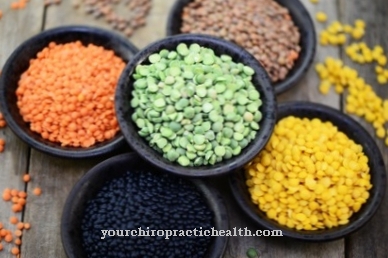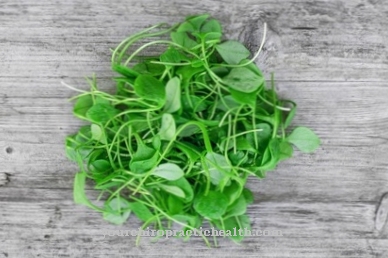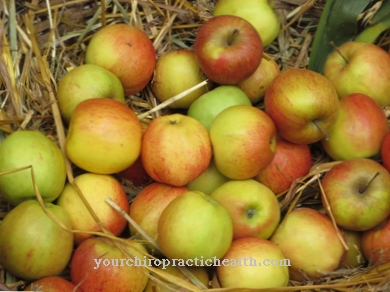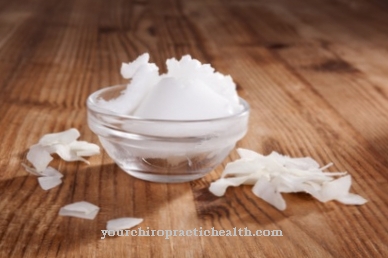spinach makes you strong, Popeye already knew that. Many children disdain it, many adults love it, and the green leaves are rich in vitamins and minerals. However, spinach also contains the dreaded nitrate, which is why a few things should be considered when preparing it.
What you should know about spinach

Spinach owes its popularity to Popeye, among others. The comic book hero always ate the green leafy vegetables from a can, which has given him superhuman strength. Around 800 grams of the green vegetables are consumed per capita and per year in this country.
The world's first spinach was probably grown in Southeast Asia, more precisely in Persia. From there it gradually reached Germany and all of Europe via Spain. Besides Germany, it is mainly grown in France and Italy.
The main season for fresh leaf spinach in this country is between April and May. Thanks to greenhouses, the green leafy vegetables can also be grown for much longer, for example from March to December. Therefore, spinach is available fresh almost all year round.
Alternatively, quickly prepared leaf and creamed spinach are available on the refrigerated shelf of every supermarket and discounter. Frozen products even make up a large part of all spinach products sold.
The taste of spinach depends heavily on when it was harvested, as different varieties have to be planted at different times of the year. A distinction is made between spring or summer spinach and autumn or winter spinach. While the first regional spinach still has very tender leaves in March, these become much stronger and spicier towards autumn and contain larger stems.
Importance to health
Due to its high iron content, spinach has long been said to have an enormous power-giving effect. In fact, however, this assumption was based on an error, as a comma had slipped out of the information about the iron content and the actual value is far below the original assumption.
Unfortunately, spinach is not a miracle cure for building muscle. Nevertheless, the green leafy vegetables are extremely healthy: they contain numerous minerals such as iron, magnesium, calcium and potassium with just a few calories. The zinc also contained strengthens the immune system. The list of vitamins it contains is also long.
However, spinach is also high in oxalic acid. This inhibits the absorption of various minerals such as iron by the body. In addition, it is often high in nitrate. However, nitrate only becomes a problem when it is converted to nitrite due to incorrect storage and preparation of the green leaves. However, spinach should not be demonized, because other types of vegetables also contain nitrate, sometimes even in significantly larger quantities. Cool storage can reduce the build-up of nitrate in spinach. When blanching, part of this nitrate is also released into the cooking water.
Ingredients & nutritional values
| Nutritional information | Amount per 100 gram |
| Calories 23 | Fat content 0.4 g |
| cholesterol 0 mg | sodium 79 mg |
| potassium 558 mg | carbohydrates 3.6 g |
| protein 2.8 g | vitamin C 28.1 mg |
Spinach also contains numerous minerals and vitamins, especially iron and zinc. The following information is based on 100 grams of fresh spinach:
- 3.4mg iron
- 0.7g zinc
- 62mg magnesium
- 117mg calcium
- 554mg potassium
- 0.8mg of vitamin A.
- 0.09mg vitamin B1
- 0.2mg vitamin B2
- 0.22mg vitamin B6
- 51mg of vitamin C.
- 1.35mg of vitamin E.
Intolerances & allergies
Spinach only causes a food allergy in extremely rare cases. Still, spinach is not good to eat for some people. Since spinach is high in histamine, people with histamine intolerance should avoid it as much as possible.
Spinach is also only suitable for infants to a limited extent, as they are far more sensitive to the nitrate it contains than adults. Before the sixth month, babies should not be offered spinach at all, from the sixth month onwards only in combination with other, low-nitrate foods.
Shopping & kitchen tips
If possible, you should always buy organically grown spinach. Conventionally grown spinach is often heavily polluted with nitrate, especially outside the main season.
Fresh spinach leaves should be washed thoroughly before preparation. To do this, the loose leaves are simply placed in a large bowl filled with water or in the sink, stirred a few times with your hands and then poured off. It is then advisable to remove the coarse ends of the handle.
It is well known that spinach should not be reheated after heating it once. This is due to the fact that nitrate can also turn into nitrite in prepared spinach. However, this advice has now been debunked as a myth. If spinach is left to cool quickly after preparation and then stored in the refrigerator or, even better, in the freezer, it can still be consumed by a healthy person without any problems even after the second warm-up.
Spinach can be kept for up to a week at room temperature. The warmer it is stored, the faster the leaves collapse. So it stays a little longer in the refrigerator. However, frozen spinach is also very popular. This can be bought ready to cook in the form of leaf, cream or different types of spinach. Alternatively, fresh spinach leaves can be blanched briefly and then frozen. Once frozen spinach leaves should be stored in the freezer until shortly before use and then gently thawed and cooked over medium heat.
Preparation tips
Spinach can be eaten raw, for example in salads, or cooked. However, given the taste, only young, tender leaves should be used for raw consumption. Pasta dishes with spinach are particularly popular. The green leafy vegetables are not only suitable for hearty dishes, they are also extremely popular as an ingredient in green smoothies. To do this, the spinach is simply pureed in a blender with various types of fruit such as bananas.
If the spinach is blanched, its volume is reduced considerably. The amount purchased should therefore not be overestimated. The water used to blanch spinach should no longer be used and should simply be thrown away. This water contains some of the nitrate contained in spinach, which is released into the water during blanching and is unhealthy in large quantities.
Since spinach contains a lot of chlorophill, it is suitable as a natural coloring agent for foods such as pasta and other things such as drugstore products.













.jpg)

.jpg)
.jpg)











.jpg)